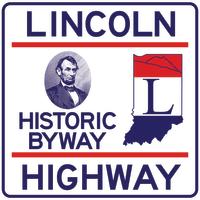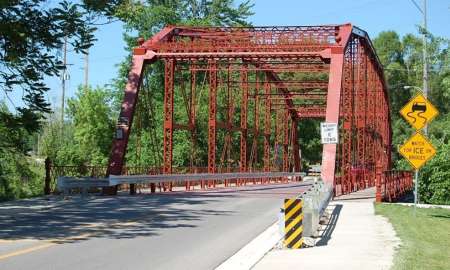Lincoln Highway Sites and Points of Interest

Driving Directions
Click here for turn by turn written driving directions.
Elkhart County East to West
BENTON AREA
Named for the politician Thomas Hart Benton, the town was platted in 1832 and grew nicely when the railroad came through in 1892, yet not much remains today.
Lincoln Highway Guidebook Entry
The 1924 The Complete Official Road Guide of the Lincoln Highway listed the population of Benton as 600. There was a post office, one auto garage, one railroad, and a telephone and telegraph service. The road was brick.
Historic Log Cabin Inn Tourist Camp (private property – please view from the roadside only.)
68306 US 33 Benton, Indiana
The Log Cabin Camp was built in the 1920s to serve travelers on the Lincoln Highway. The theme of log cabins harkens back to the days of Abraham Lincoln, whose name was given to the transcontinental road as a lasting and living memorial.
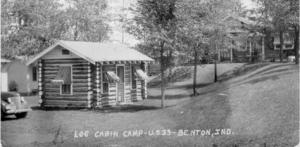
This postcard image from the 1930s shows the charm of the log cabin camp.
Courtesy Russell Rein.

The cabins today. Courtesy Jan Shupert-Arick
Few remaining tourist cabins exist along the Lincoln Highway, making these tourist cabins a unique resource in Elkhart County. When this site served Lincoln Highway travelers it included 2 small tourist cabins, a main cabin with a dining room and a kitchen, and a family sleeping cabin. This site also provided gasoline, a café, and an outdoor fireplace for cooking. In recent years the cabins have been undergoing restoration and have been added to the National Register of Historic Places.
Benton Landing-River Preserve County Park/Recreational Opportunity
68105 US 33 (four miles south of Goshen) https://ElkhartCountyParks.org/destinations/river-preserve/
This area offers unique recreational opportunities for travelers and residents alike. On the north side of the bridge over the Elkhart River there is kayak and canoe access on the west side of the road. At this public access point, you can park and paddle the river to the north toward Benton and Goshen (a 4-mile paddle). The “on the water” experience provides beautiful scenery and access to trails, picnic, and restroom facilities. This is a unique opportunity to imagine what the area was like before settlement days.
GOSHEN
The town developed between 1840 and 1930. The Lincoln Highway generally follows US Highway 33 through town, although it leaves the highway on the west side. It is well marked with red, white, and blue Historic Byway signs.
The City of Goshen erected large and impressive signs on the Lincoln Highway in 1914 to welcome travelers. The signs listed the mileage to San Francisco and New York (810 miles to Times Square in New York and 2,579 miles to Lincoln Park in San Francisco). Large metal posts on each end of the signs held light fixtures manufactured by the Cutter Light Company in South Bend. Each light fixture included an arrangement of four round white globes which were lit at night. The top globes were striped with red and blue bands and announced to travelers that they had arrived in Goshen. Fragments of one sign erected north of the Old Bag Factory (now on display at the Goshen Historical Museum) were found when the Martin’s Grocery Store was built on Chicago Avenue in 2006. Notice the Old Bag Factory in the background on the left.

Courtesy Russell Rein
Lincoln Highway Guidebook Entry for Goshen
The guidebook warned drivers that the local speed limit was 8-15 miles per hour and it was enforced! In Goshen 5 banks, 2 interurban lines, 2 telephone companies, 2 newspapers, and a local trolley service were listed. The city boasted the first Carnegie Library in Indiana in 1901 and a tourist campground. Ulrey’s Triangle was located at the city limits west on the Lincoln Highway where tourists could buy gas and camp overnight. Their business ad included advertising for a ladies’ rest room!
Fidler Pond Park/Trail and Lincoln Highway Gazebo Exhibit
1424 E. Lincolnway (US 33) Goshen, IN
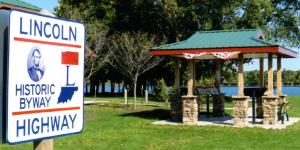
Operated by the Goshen Parks and Recreation Department, Fidler Pond Park has something for everyone. Located on the original 1913 route of the Lincoln Highway, the 80-acre pond offers canoe and kayak rentals, fishing and fishing pole rentals, catch and release fishing, swinging benches, and an accessible walking trail.
When you visit Fidler Pond Park, be sure to stop at the Lincoln Highway gazebo to learn about the historic Lincoln Highway that ran from New York City to San Francisco more than 100 years ago. The gazebo exhibit includes four interpretive panels that share intriguing historical images, historic maps, and stories. The gazebo was funded through the efforts of the Indiana Lincoln Highway Association (INLHA), Reith Riley Construction Company, and the City of Goshen. For more information about the Indiana Lincoln Highway Byway visit: www.indianalincolnhighway.org

Automobile Green Book Vol. 3, 1921, Scarborough Motor Guide Company, Indianapolis, Indiana
The Goshen Carnegie Library (on the left) is located at 202 S. 5th Street and today serves as the Goshen City Hall. It was built of Indiana limestone and is listed on the National Register of Historic Places.
DOWNTOWN HISTORIC DISTRICT

This postcard image of Main Street in Goshen was taken in the 1920s and shows the businesses south of Lincoln Street. Notice the courthouse dome, the early automobiles, the trolley coming down Main Street, and the flatbed delivery trucks.
Courtesy Goshen Historical Society
As you drive through Goshen look around and notice that the downtown commercial area is filled with historic buildings dating as far back as the 1870s. Goshen is understandably proud of its National Historic District which includes over 700 buildings in the downtown and surrounding residential area, one of the largest historic districts in the state. It includes excellent examples of both Italianate and Queen Anne style architecture. Most of the upper facades of the buildings reflect the Italianate architectural style featuring brackets under their overhanging eaves and tall, narrow windows. Many of these buildings were filled with businesses that served early travelers on the Lincoln Highway in the 1920s.
In 2007 the Goshen city government established protections for the historic commercial structures in order to preserve the historic character of the city. The district was placed on the National Register of Historic Places in 1983.
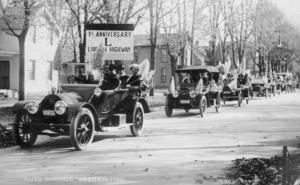
In 1914, an auto parade was held in Goshen to celebrate the first anniversary of the highway. Courtesy Russell Rein.
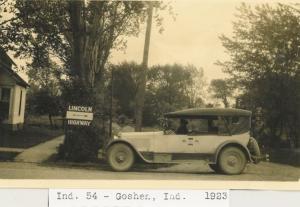
Vehicle driving through Goshen in 1923. Courtesy University of Michigan/Lincoln Highway Collection
Goshen Theater
210 South Main Street Goshen, IN 42526
The historic Goshen Theater is in the heart of the city’s Arts and Culture District and has recently completed a $5 million renovation. The theater houses a 600-seat auditorium, concessions and bar area, second-story offices, and a third-story ballroom that serves as a flexible space for special events. The original theater on this site was constructed in 1905 as the Jefferson Theater. Fourteen months after opening, the theater burned but was quickly replaced with the present building completed in 1907. It was renamed the Goshen Theater in 1948 when it was converted from a playhouse to a cinema. In 1986 the theater closed due to a decline in downtown commercial activity. The building struggled for tenants until 2021 when local civic leaders rallied to preserve the theater and raised the needed funds.

Goshen Theater Courtesy SHARD
Goshen Historical Society & Museum ("The Adams Store")
124 S. Main Street Goshen, IN 46526
574-975-0033
Goshen has a very active historical society. Since 1998 the society has operated the local history museum in the former Adams store at 124 S. Main Street, along the route of the Lincoln Highway. The Adams store building was constructed in 1888 as part of the Harper Block. C.G. Adams & Sons opened their "jewelry & gent's furnishing store" in 1901. When it closed in 1997 the Goshen Historical Society purchased the building that had been owned and operated by members of the Adams family since 1901.
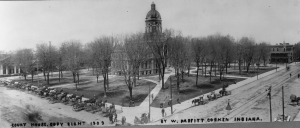
Elkhart County Courthouse and Courthouse Square
101 North Main Street Goshen, IN 42526
Tip: If you have time, park and get out of your vehicle to stroll the area.
The Elkhart County Courthouse Square as it appeared in 1909 just 4 years before the Lincoln Highway was organized. Notice that there is only one automobile (lower right-hand corner) in the photo. This photograph was taken by W. Parfitt. Courtesy Library of Congress.
The Elkhart County Courthouse stands in the center of town, at the intersection of Main Street and Lincoln Avenue. The courthouse is a beautiful structure in its own right but the grounds also hold the unusual Neptune Fountain, the police booth, and the county war memorial. The Courthouse is a Goshen landmark and is also located on the original route of the Lincoln Highway.
The original county seat for Elkhart County was in Dunlap (1831-1833), an area in between the cities of Elkhart and Goshen. The second courthouse was in Goshen and designed by Jacob Studebaker, serving the county until it was razed in 1868. It was replaced with the current building designed by the Chicago architectural firm of Barrows and Guernsey and is an excellent example of the Renaissance Revival style of architecture. It is 3 stories high with a domed tower and is listed on the National Register of Historic Places. At one time an underground tunnel connected the courthouse to the old jailhouse but that has been filled in today. An early Abraham Lincoln portrait (1860) hangs in the judge’s chambers and an interesting fountain of Neptune stands in the courthouse yard, a gift to the city from a grateful Greek confectioner in 1912.
Because of its central location the courthouse is a good place to park and explore downtown Goshen. It's within easy walking distance of the Olympia Candy Kitchen, Sorg Jewelers, the former site of the Alderman Hotel, the WPA Goshen Police Booth, the Goshen Historical Museum and a score of other stores, coffee shops, and historic buildings.
Goshen Police Booth – Protecting the Goshen Community
Courthouse Square at Lincoln and Main Streets
Goshen, IN 46526

Goshen Police Booth Courtesy Goshen Historical Society
At the intersection of Lincoln and Main Streets on the courthouse square is a unique WPA project. It is a holdover from the Great Depression era of the 1930s. Owned by the Goshen Historical Society since 1996, the octagonal-designed police booth was built of Indiana limestone and features two-inch-thick bullet proof glass, pistol port holes and a revolving machine gun cupola.
The City of Goshen erected the police booth in 1939 at this strategic intersection in order to protect the city from gangsters who might travel along the transcontinental Lincoln Highway looking for a bank to rob. Even though the gangsters that it was meant to protect against were mostly gone by the time it was finished in 1939, the Police Booth served as the dispatch center and was manned 24/7 until 1966. It's a unique part of Goshen’s history that lies along the historic Lincoln Highway.
The Police Booth Timeline
1939-1966: Police telephone center; 24/7 police presence for public access; location of fire siren sounded to clear intersection when fire vehicles approached Lincoln and Main; the place to pay any parking ticket fines.
1967-1969: Police radio transmitting headquarters and information center. All calls for help to police were handled in the booth with officers being dispatched where needed.
1969-1983: Headquarters for city’s parking meter maids and a visitor center.
1983-present: The City of Goshen donated the Police Booth to the Goshen Historical Society. After some restoration and other improvements, the Police Booth was re-dedicated as a historical site in 1996.
Police Booth Public Hours - The police booth is open for public viewing during designated First Friday celebrations from 5:00-8:00 p.m. local time. Special tours may be scheduled by calling the Goshen Historical Society at 574-975-0033.
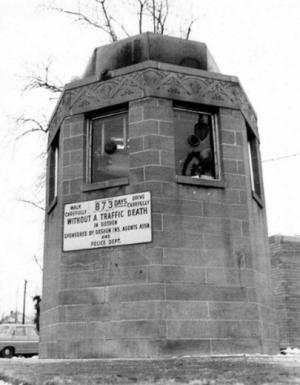
Goshen Police Booth Image Courtesy Goshen Historical Society
The Olympia Candy Kitchen
136 N. Main Street Goshen, IN 46526
574-533-5040
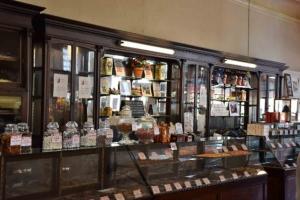
Handmade candy on display in the Olympia Candy Kitchen Courtesy Lincoln Highway Association
Established in 1912, a year before the Lincoln Highway, the Olympia Candy Kitchen located across the street from the Courthouse at Main and Clinton Streets is world famous for their chocolates.
Greek immigrant, Nicholas Paflas, purchased the candy kitchen and began crafting hand-dipped chocolates made from scratch. He and his wife added a diner with a soda fountain and became established business owners in the Goshen community.
From its humble beginnings, the Olympia Candy Kitchen has remained a family business, passed down from generation to generation, but retaining the family recipes.
The Olympia Candy Kitchen has retained its charm and contributed much to the rich cultural history of downtown Goshen. The Olympia continues to be a local gathering spot and its chocolates have been enjoyed by a number of U.S. presidents. Stop in to meet members of the fourth generation of the Paflas family and enjoy the bonbons, chocolate covered cherries, peanut clusters, and the ever-popular turtles!
Historic Through Truss Metal Bridge on River Avenue
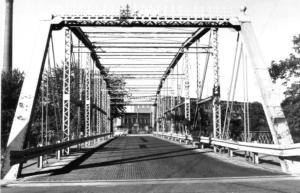
This 1988 image of the River Avenue Bridge shows its elaborate metal detailing. Notice the Old Bag Factory on the far side of the bridge
Courtesy Indiana Department of Natural Resources, Division of Historic Preservation and Archaeology
A Pennsylvania metal through truss bridge near the Old Bag Factory on Indiana Avenue is located on an early alignment of the Lincoln Highway used by the U.S. Army’s Transcontinental Motor Convoy in 1919. Built in 1896, this bridge was the most elaborate metal bridge constructed in Elkhart County. Through the years it has been known by many names including the Elkhart County Bridge Number 403, Fort Wayne Street Bridge, River Avenue Bridge, and the Indiana Avenue Bridge.

Courtesy National Register Nomination
The bridge was built by the Bellefontaine Bridge and Iron Company in Bellefontaine, Ohio. Thanks to the Goshen Historical Society, the bridge was restored in 1986 and listed on the National Register of Historic Places.
DRIVING TIP: As you pass the bridge be sure to notice the early gas station near the bridge. You will also pass in front of a century-old brick building known today as the Old Bag Factory. The heating plant and smokestack have been local landmarks since the early 1940s.
The Old Bag Factory
1100 Chicago Avenue Goshen, IN
574-534-2502
The site offers free parking and restrooms. Stop in to explore this interesting historic factory building filled with memorabilia, artifacts, and uniquely hand-crafted products. Hours: Monday-Friday: 9am-5pm/ Saturday: 9am-4pm/Sunday: Closed.
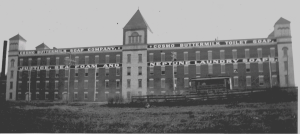
Courtesy Larion Schwartzendruber
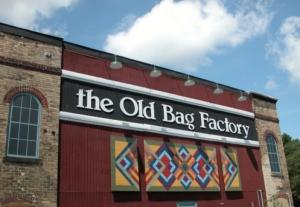
Courtesy Indiana Lincoln Highway Association
Originally built for the Cosmo Buttermilk Soap Company in 1896 by J.J. Burns of Chicago, the 80,000 square foot soap factory had all the modern equipment. Soaps were boiled on the first floor, cooled in the basement, milled on the second floor, and dried on the third floor. The company manufactured 15,000 bars of soap each month and shipped to both European and American markets.
The local trolley line once ran along the street and across the bridge to bring owners and workers to the factory. Eventually the factory was purchased by Chase Bags. The last fertilizer and feed bags produced here were in 1975. Another fascinating piece of trivia: one of their top volume products was the paper strip in a Hershey kiss!
In 1984, Larion and Nancy Swartzendruber purchased the structure for their handcrafted furniture-making business and created a place for local artists and craftsmen to produce and sell their work, including pottery and musical instruments. The Old Bag Factory is also home to a catering business, a virtual reality and escape room, and more.
ELKHART
Elkhart was founded in 1831 when Dr. Havilah Beardsley paid $1,500 to purchase one square mile of land at the confluence of the St. Joseph and Elkhart Rivers from Pierre Moran, a Potawatomi Indian chief. The following year, Elkhart was platted with 51 lots. It is believed that the name Elkhart was taken from the Shawnee Indian Chief Elkhart who was a cousin of the famous Chief Tecumseh.
It was with great excitement that the citizens of Elkhart celebrated the creation of the Lincoln Highway in the early1910s. Welcome signs were erected along the road and citizens gathered for parades and celebrations as local businesses lured travelers to their newly-created establishments that provided gasoline and oil, food, and lodging options.
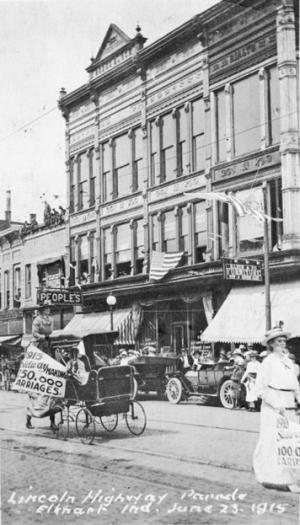

Elkhart Lincoln Highway Parade, June 23, 1915 Images Courtesy Russell Rein


Lincoln Highway Day enthusiasts outside of the Bucklen Hotel Images Courtesy Russell Rein
Map of the City of Elkhart showing the two routes of the Lincoln Highway through Elkhart. The route to go downtown to the commercial district followed Main Street to Jackson Street and then left on Vistula to Franklin. Those Lincoln Highway travelers who wished to avoid downtown made a left hand turn on Marion Street and then a left onto Franklin. (The Automobile Green Book Volume 3, 1921, published by the Scarborough Motor Guide Company, Indianapolis, Indiana)

As the travelers began to arrive on the Lincoln Highway, the Elkhart County Commissioners increased their budgets to pay for improved roads at an impressive pace. Concrete and brick roads were completed by 1919 across the county. Reith-Riley was an early road construction leader and remains a northern Indiana leader 100 years later. Their corporate offices are along the Lincoln Highway near Dunlap.
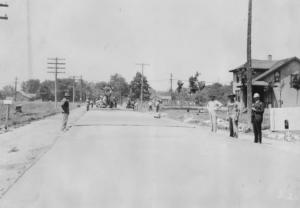
Work crews pave the Lincoln Highway between Elkhart and Osceola in 1918. Courtesy of the LHA Collection/University of Michigan
VEHICLE MANUFACTURING HISTORY IN ELKHART COUNTY
Elkhart auto manufacturers produced thirty-five different vehicles between 1900 and 1935 and were part of the early automotive industry boon in the Midwest. The Crow-Elkhart Motor Company manufactured automobiles from 1909 to 1924 and the Elkhart Motor Car Company produced vehicles from 1916-1931. The vehicles were manufactured in a craftsmen style and not on assembly lines.
According to the Handbook of Automobiles 1915-1916, the Elkhart Carriage and Motor Car Company produced the Elcar Touring Car which sold for $795.00. The five passenger, four-cylinder boasted a three-speed engine with 19.6 horsepower and an electric lighting system which operated from a six-volt battery.

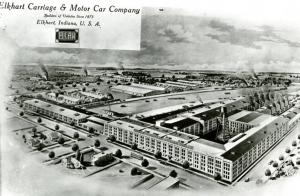
This is an image of an artist's rendering of an aerial view of the Elkhart Carriage & Motor Car Co. buildings located at Beardsley and Michigan Avenue. In upper left corner there is a cut-out area reading "Elkhart Carriage & Motor Car Company/Builders of Vehicles Since 1873/Elkhart, Indiana, U.S.A." followed by the Elcar logo. Date: unknown. Courtesy Indiana Memory
Elkhart County is known today as the Recreational Vehicle Capital of the World. That line of manufacturing companies dates back to 1934 when the first trailer factory opened in Elkhart. It was followed by similar businesses.
An Interurban Trolley still operates today and provides easy, affordable public transit along the corridors, connecting Elkhart and Goshen residents and visitors to its major points of commerce between the two cities. The Trolley also provides a viable connection to the South Bend and Mishawaka areas via a transfer point with Transpo’s Yellow Line, providing greater access and quality of life for the Michiana region.
ELKHART RAILROAD HISTORY
Elkhart has a long and rich railroad history that dates to the mid-19th century when the first train arrived in 1851. Although the state legislature chartered a railroad in 1838 to run from Indiana’s eastern boundary to Michigan City, nothing immediately came of this effort. The railroad finally arrived in Elkhart on a late Friday afternoon in October 1851 to great celebration that included public gatherings and bonfires. People flocked to the town from the surrounding area as the railroad had promised a free excursion on the new line. Years later the Michigan Southern & Northern Indiana Railroad (the Lake Shore Railroad) provided a connection to Buffalo, New York and points further east through Cornelius Vanderbilt’s New York Central line.
Located at the junction point of the Lake Shore & Michigan Southern main line and Air Line, Elkhart was a natural location for a rail maintenance complex that included locomotive works, repair shops, a carpenter shop, boiler shop, two round-houses, freight houses, and offices. Begun in 1870 one mile west of the downtown depot, in just 20 years the collection of shops employed more than 1,200 people and Elkhart became established as a major railroad hub.
In time the Lake Shore freight yards developed into a classification area where the railroad could assemble freight trains. Only 100 miles from Chicago, a major Midwestern and continental rail center, sorting the cars at Elkhart made sense as it avoided potential delays and confusion that might have resulted from locating the yard in the metropolis. Trains assembled in Elkhart could simply cruise on through the busy Chicago rail yards and crossings on their way west. This freight yard is located along yet another later alignment of the Lincoln Highway west of Elkhart.
By 1914, the Lake Shore and Michigan Southern merged with the New York Central and Hudson River Railroad to form the “new” New York Central—a move which guaranteed Elkhart a continued, important role as part of the NYC System. Just as when the railroad first arrived in Elkhart in 1851, Elkhart today functions as a vital link in the chain connecting the Atlantic Seaboard with the Midwest and beyond. Approximately 75 trains and up to 3,200 rail cars pass through the Elkhart yard today.
ELKHART DOWNTOWN COMMERCIAL DISTRICT
Surrounded by the rivers and railroads that shaped it, downtown Elkhart lies on a grid skewed toward the northwest. The Elkhart Downtown Commercial District contains a fine collection of late nineteenth and early twentieth-century commercial buildings strung along approximately eight blocks of Main Street, which roughly parallels the general direction of the meandering Elkhart River as it flows into the St. Joseph River. The south side of the 100 block of East Franklin Street is also part of the district. Near its north end, the district also includes two blocks of Lexington Street flanking Main, and the east side of Second Street between Lexington and Jackson.
National New York Central Railroad Museum and Archival Library
721 South Main Street Elkhart, IN 46515
574-294-3001
The National New York Central Railroad Museum recaptures the glory days when America’s railroads were symbols of progress and goodwill ambassadors across the country. The Museum was founded in 1987 and is an ever-growing preservation site of both local and national railroad heritage pertaining to the New York Central System.
The New York Central was once the second-largest railroad in the United States, with 11,000 route miles of track in eleven states and two Canadian provinces. Elkhart is a natural home for the Museum: the New York Central’s Robert R. Young Yard (now Norfolk Southern Railway’s Elkhart Yard) is the second-largest railroad freight classification yard east of the Mississippi River.
The National New York Central Rail Road Museum has so much to offer! Attractions include rolling stock such as the Mohawk 3001, an NYC E-8, and interactive exhibits geared toward both adult train enthusiasts and fascinated children. Bring the whole family for a fun day of excitement and learning!
Elkhart Train Station
131 Tyler Street Elkhart, IN 46515
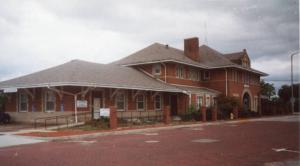
The current Amtrak station sits across the tracks from the National New York Central Railroad Museum. Courtesy Indiana Memory
Built in 1900 by the Lake Shore and Michigan Southern Railroad, the Elkhart Depot has an impressive limestone arch at the main entrance in a design reminiscent of the late 19th century Richardsonian Romanesque architectural style. Trackside, a deep eave runs the length of the platform to shelter passengers from inclement weather. The sturdy brackets are supported by stone bases. The station was originally set amid a well-kept garden that displayed manicured beds of colorful flowers and a row of trees along the tracks creating a lovely introduction to the city for first-time visitors. The gardens also provided a buffer from the noise and dirt associated with steam engines and freight trains of the times.
Today the depot is served by two Amtrak trains – the Capitol Limited between Chicago and Washington D.C. and the Lake Shore Limited between Chicago and New York City and Boston. The historic station has a waiting room but it has limited hours, open in the early mornings and late evenings half an hour before the first westbound and eastbound trains arrive.
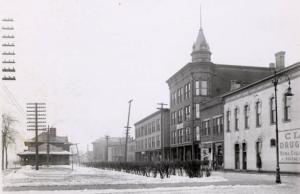
This historic photograph captures Tyler Street looking west. This street once featured a number of significant buildings near the New York Central depot. The Depot Hotel, the Kaiserhof, and a YMCA building once stood proudly in this part of the city. All have been removed except for the train depot. The razing of the buildings took place in the 1960s when a new post office was built. Today, the historic depot serves as the Elkhart Station for Amtrak and receives an east bound and a west bound train each day. Courtesy Elkhart Public Library
Hotel Elkhart
500 S. Main Street Elkhart, IN 46516
574-389-7900
Courtesy of the Elkhart Public Library This postcard view of Hotel Elkhart (c1950) illustrates the hotel’s status in downtown Elkhart at the corner of South Main and East Marion Streets.
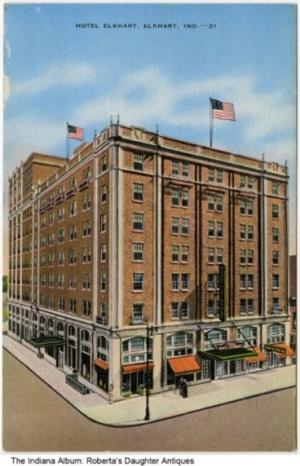
Since 1923, Hotel Elkhart has been a source of pride in the local community. The property was originally constructed as a hotel and featured a coffee shop, restaurant and various meeting spaces. During this time, it served as a hub for business leaders, travelers and even some notable people in history such as Ed Sullivan and Robert Kennedy. The building functioned as a hotel until the early 1970s and then was utilized as an office building and apartment complex. It has also housed several different restaurants and retail spaces over the years.
Newly opened in the fall of 2021 this fine historic hotel has been beautifully restored to its jazz-age grandeur. Great care has been taken to preserve many of the historical elements of the building, including the beautiful plaster ceilings in the lobby with intricate relief moldings, the terrazzo floors on the first-floor lobby and food and beverage spaces, along with the ballroom ceiling and cornices and the second-floor mezzanine windows, which have all been thoughtfully restored.
Today Hotel Elkhart offers 93 guest rooms, two restaurants, ballroom, meeting space and a rooftop bar. Breakfast, lunch and dinner are served in Relish Café & Confections. The Corner Bar, rightfully placed on the corner of Main Street and Marion Street, offers high-end cocktails, small-plates and lite-fare dinner. Additionally, the newly redesigned Aria Ballroom and Prelude pre-function space located on the ninth floor accommodates larger groups. The property also offers small meeting rooms and boardrooms.
Lerner Theatre (The Warner, ELCO Theatre)
410 South Main Street, Elkhart, IN 46516
574-293-4469

The Lerner Theatre when it was the ELCO, c 1936 Courtesy: National Register Nomination
The Lerner Theatre is set in the heart of Elkhart. The historic theatre is part of the revival of commerce and the arts in downtown. The theatre boasts its original 1920-era Kimball pipe organ.
Built in 1924, in the early years of the Lincoln Highway the Lerner was designed to host vaudeville shows and serve as a movie palace. This architectural gem was designed in the Classical Revival and Beaux Art Styles and decorated with elaborate terra cotta details and impressive columns.
Since Elkhart was located on a national railroad hub the theatre took advantage of many major shows traveling by rail between New York and Chicago. Harry Houdini, Buster Keaton, and the Clyde Beatty Circus are a few of the historic shows once featured at the Lerner.
During the Great Depression of the 1930s the theater was purchased by the Warner Brothers who renamed it The Warner. They added a waterfall curtain which is one of only a few still in operation across the nation. In 1934 it was renamed the ELCO. The theater has changed owners several times over the years but is now owned by the city.
Added to the National Register of Historic Places in 1980, the theater underwent an $18 million renovation between 2009-2011 adding a reception and ballroom space. Restored to its original luster, the theatre is once again a gem in downtown Elkhart and serves as an anchor to the Downtown Commercial Historic District.
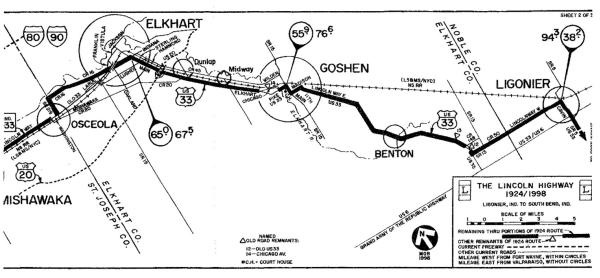
Courtesy Michael Buettner
FOR MORE INFORMATION:
The Rivers and the Native Americans Historical Marker (hmdb.org)
https://www.pokagonband-nsn.gov/citizens/gallery/people-and-places
Indiana Memory
Advisory Council on Historic Preservation - City of Elkhart
Elkhart County CVB
City of Elkhart
Elkhart County Historical Museum
Elkhart Railroad History
Lerner Theatre
Goshen Historic District
Goshen Parks and Recreation
Goshen Historical Society
Indiana Lincoln Highway Association - Contains printable turn-by-turn guides in each direction for each of the eleven counties and other information about Indiana’s Lincoln Highway.
SELECTED SOURCES
A Complete Official Road Guide of the Lincoln Highway, Fifth Edition, Lincoln Highway Association, 1924, Detroit, Michigan.
History of Elkhart County, Indiana; together with sketches of its cities, villages and townships, educational, religious, civil, military, and political history: portraits of prominent persons, and biographies of representative citizens. Chicago, C.C. Chapman & Co., 1881. https://www.loc.gov/item/rc01001648/
THE IMPORTANCE OF PRESERVING HISTORIC ROADS
Yet for such a powerful imprint to be placed on the landscape, very little has been said about the need for the preservation of our highways and byways. It has only been in recent years that serious efforts and legitimate dialogue have begun to address the preservation of the routes and corridors that bind us together from state to state and nation to nation – our historic roads.
Paul Daniel Marriott, author Saving Historic Roads and From Milestones to Mile-Markers https://historicroads.org/historic-roads/
Increasingly, communities across the United States and beyond are beginning to recognize that their roads are historic. Historic freeways, transcontinental highways, parkways, farm-to-market roads and traffic circles are being studied, inventoried, debated and discussed in the newest movement in the historic preservation world. Driving my way, on the Lincoln Highway?
Horvath, Dennis, Indiana Cars A History of the Automobile in Indiana, Jackson Press, Indianapolis, Indiana, 2002
CREDITS
Funding for this project was made possible by the Indiana Lincoln Highway Association, Indiana Landmarks, Indiana Humanities, and the National Endowment for the Humanities. We also thank the Elkhart County Convention and Visitor Bureau for its assistance in producing and promoting the online version of this driving tour across Elkhart County. Special thanks to the Goshen Historical Society, the University of Michigan, Indiana Memory, Russell Rein, Jeff Blair, and others for sharing images and information related to the tour.
Jan Shupert-Arick, Author and Researcher Jeff Blair, Editor
Beverly Gillespie, Project Director
